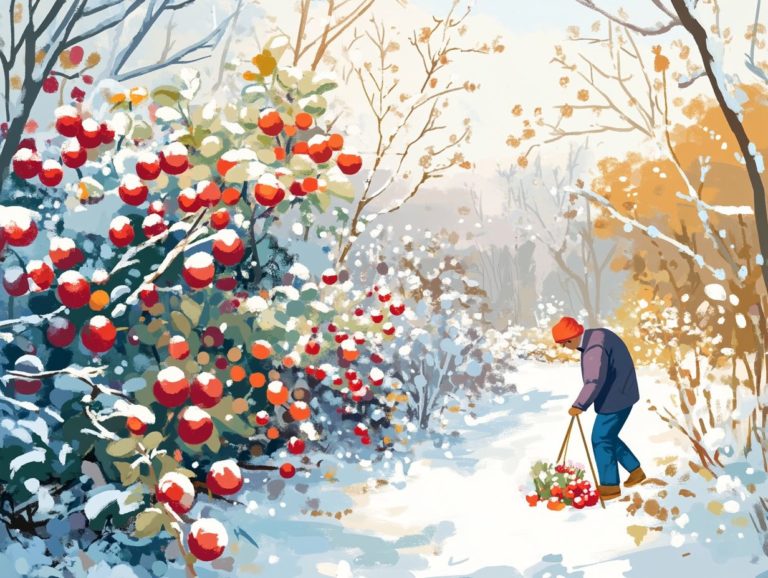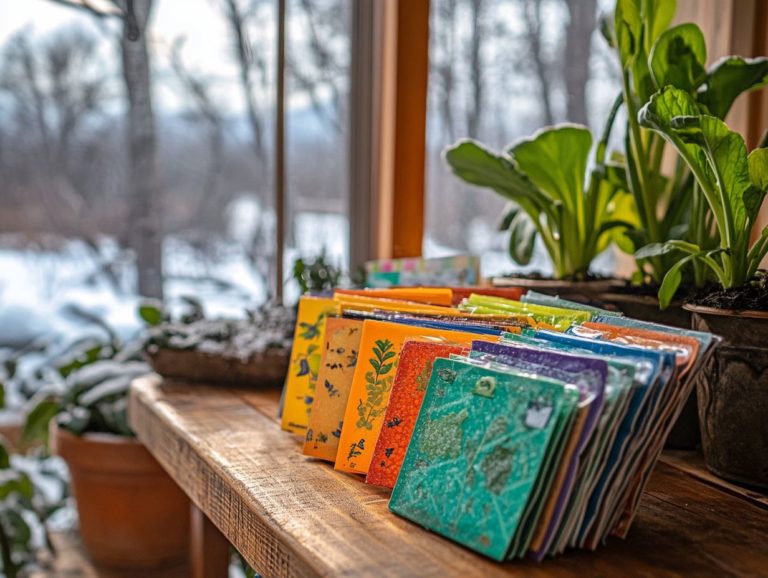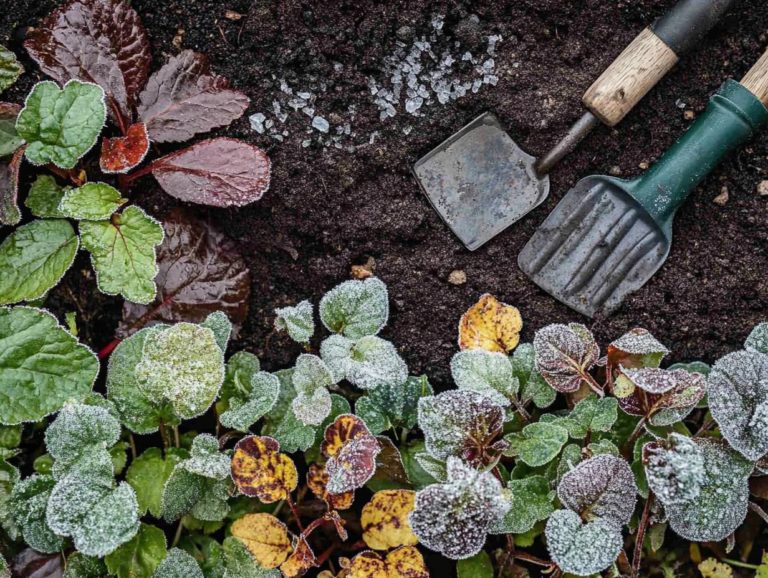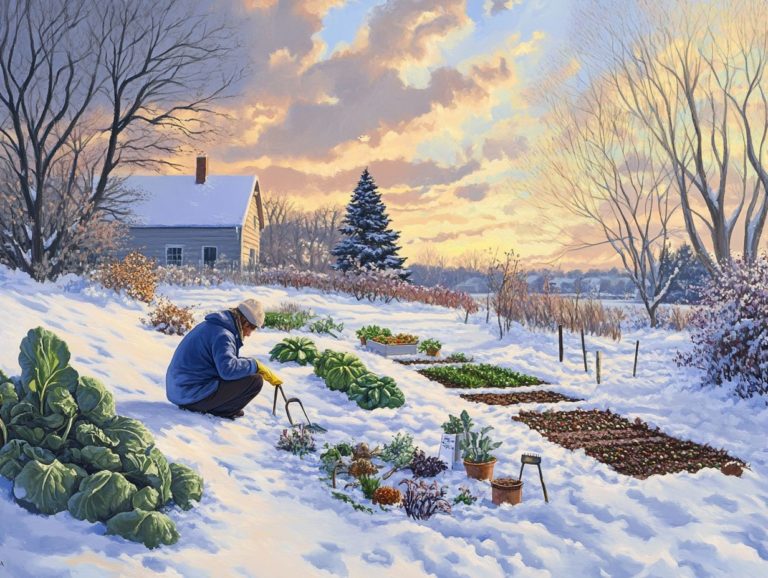What Mulching Techniques Work Best in Winter?
As winter draws near, you might find yourself pondering the best ways to shield your plants from the impending chill. Mulching stands out as a formidable ally in this endeavor, providing insulation and a protective barrier against frost.
This article will guide you through the various types of mulch that are ideal for winter. You’ll uncover the myriad benefits of mulching, learn effective mulch application techniques, and identify common pitfalls to steer clear of.
Arm yourself with practical gardening tips to ensure your garden not only survives but thrives throughout the cold months ahead.
Contents
- Key Takeaways:
- Understanding Mulching in Winter
- Types of Mulch for Winter
- Benefits of Mulching in Winter
- Best Mulching Techniques for Winter
- Common Mistakes to Avoid
- Frequently Asked Questions
- What Mulching Techniques Work Best in Winter?
- What is mulch and why is it important in winter?
- What types of mulch are best for winter?
- What are the benefits of winter mulch?
- How thick should the mulch layer be in winter?
- When is the best time to apply mulch for winter?
- How to prepare for winter mulch removal?
- Do I need to remove the mulch in spring?
- Are there any plants that do not need mulching in winter?
Key Takeaways:
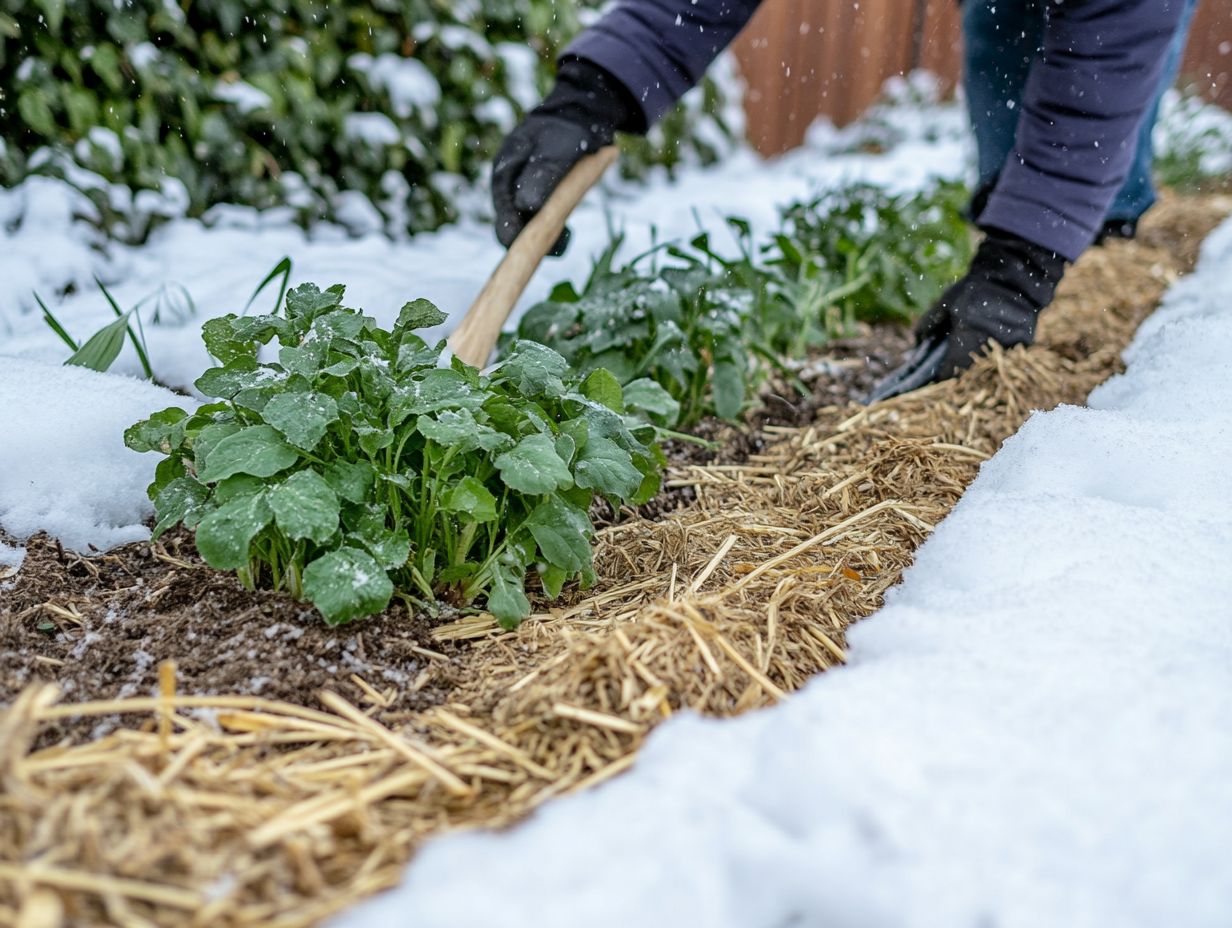
- Mulching in winter is crucial for protecting plants from extreme temperatures and providing insulation.
- Organic mulch is preferred as it helps regulate soil temperature and provides nutrients for plants.
- Layering and proper application are important for effective winter mulching; avoiding common mistakes can lead to successful results.
Understanding Mulching in Winter
Understanding the significance of mulching in winter is essential for your gardening success. It involves employing a variety of materials, including organic options such as pine needles and bark chips, to shield your plants from frigid temperatures, retain moisture, and regulate soil temperature.
Mastering effective mulching techniques can greatly enhance the health of your garden. This practice prevents frost damage while also elevating your garden’s aesthetics during those dreary winter months, especially when you consider best practices for winter gardening.
By adopting proper mulch covering strategies, you can ensure that your plants, particularly shallow-rooted species, not only survive but thrive under winter conditions. This effectively combats the challenges of frost, crown rots, and diseases.
What is Mulching and Why is it Important in Winter?
Mulching is an essential practice that involves covering soil with organic or inorganic materials to enhance soil health and protect your plants especially during winter when frost damage can be a serious concern.
This technique also provides a protective shield for your plants, playing a crucial role in moisture retention. It creates a barrier that reduces evaporation, ensuring that vital moisture remains accessible to the roots, even in the coldest months.
Additionally, mulch acts as an insulating layer, keeping soil temperatures stable. After all, temperature fluctuations can stress your plants and lead to damage. Whether you re a novice or an experienced gardener, implementing a solid fall mulching strategy is essential for protecting your tender plants and promoting healthier growth through seasonal changes.
Types of Mulch for Winter
When selecting the ideal mulch for winter, you have an array of choices. Consider organic materials such as pine needles, bark chips, and compost, which offer natural benefits, alongside inorganic options that deliver unique advantages.
Each type serves a purpose, allowing you to tailor your garden’s winter protection to meet your specific needs and combat weeds.
Organic vs. Inorganic Mulch
Organic mulch, crafted from materials like leaves, straw, or bark chips, gradually enhances soil health over time. On the other hand, inorganic mulch offers durability and requires minimal maintenance, making each option ideal for different gardening objectives, particularly in frost-prone areas.
As organic mulch breaks down, it enriches the soil, delivering essential nutrients that foster beneficial microbial activity. This decomposition not only enhances soil structure but also boosts moisture retention, allowing water to infiltrate more effectively.
In contrast, inorganic choices such as gravel or recycled rubber create a long-lasting barrier that minimizes evaporation, preserving soil moisture but not contributing any nutrients.
While both types are effective at suppressing weeds, the ecological advantages of organic materials often position them as the preferred choice for those dedicated to cultivating healthy, vibrant ecosystems in their gardens.
Benefits of Mulching in Winter
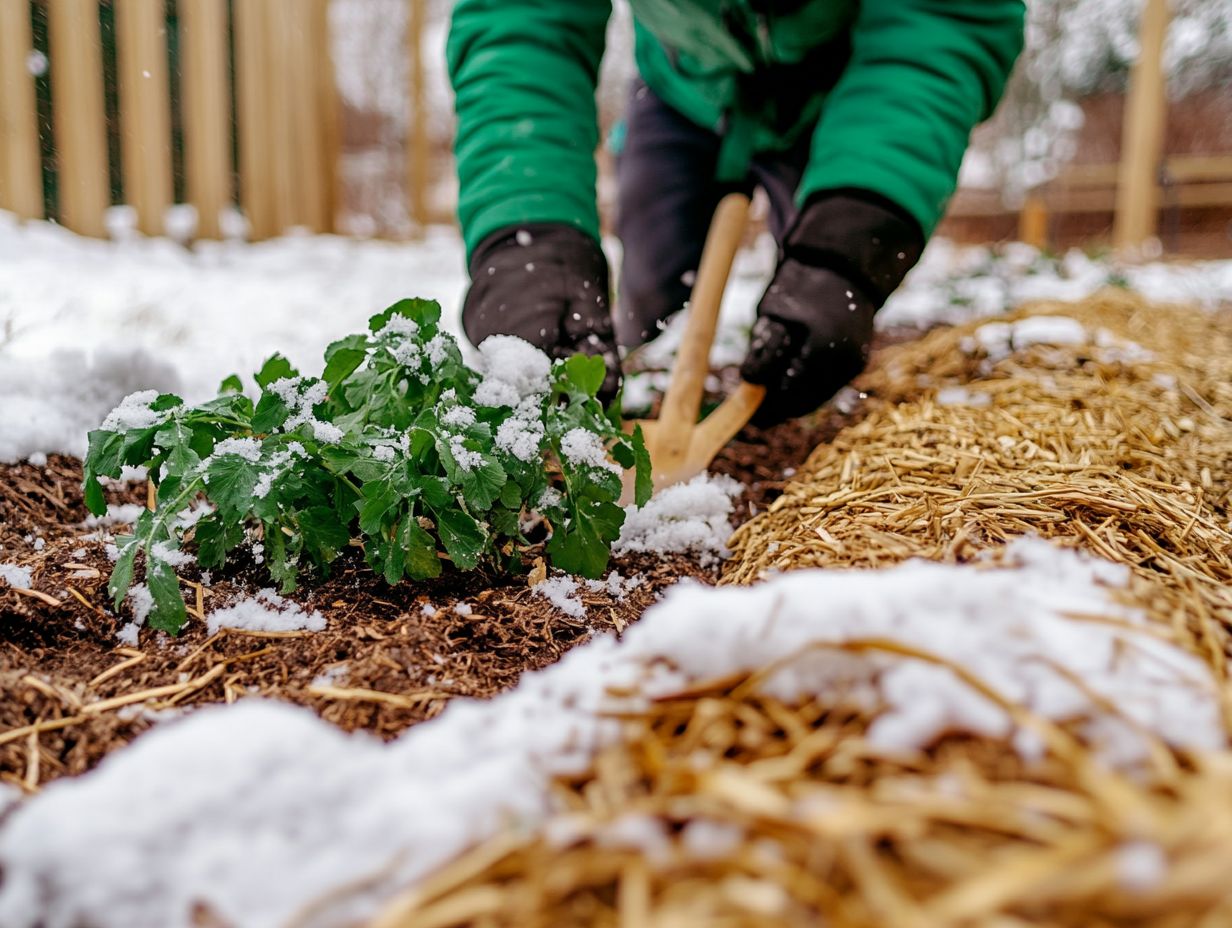
The advantages of mulching in winter are plentiful. It provides enhanced protection for your plants, improves insulation, and boosts moisture retention. Together, these benefits significantly contribute to the overall health of your garden, especially during extreme cold temperatures.
Insulation and Protection for Plants
One of the essential functions of mulch during the winter months is its ability to provide insulation. This safeguards your plants from frost damage and helps avert complications like crown rots, which can damage the base of your plants, and pathogens, harmful microorganisms that can cause disease.
By forming a protective barrier between the soil and the biting cold air, mulch works to maintain a more consistent temperature within the soil below. This thermal shield captures heat from the ground, significantly reducing the likelihood of your roots succumbing to freezing during particularly harsh spells.
Mulch also acts as a moisture reservoir, preventing the soil from drying out an enemy to plant health. The materials you choose, such as wood chips, straw, or leaf litter, have different insulating properties. This gives you the power to select the most appropriate option for your specific climate and plant requirements.
Best Mulching Techniques for Winter
Applying the finest mulching techniques in the fall can remarkably elevate the efficacy of winter mulch. This practice not only ensures optimal protection for your plants but also enhances the overall health of your garden, as outlined in our guide on winter mulching: benefits and best practices.
Layering and Application Methods
Implement proper layering during mulch application. This is crucial for achieving optimal moisture retention and providing adequate protection for your plants.
When done thoughtfully, mulch serves a dual purpose: it conserves moisture and regulates soil temperature, creating a healthier environment for growth. To reap these benefits, aim for an ideal layer thickness of about 2 to 4 inches. This ensures that the mulch isn t too dense, which could obstruct water and air from penetrating the soil.
Selecting organic materials like wood chips, straw, or grass clippings is essential. These will break down over time and enrich the soil with vital nutrients. To apply mulch effectively, start from the base of your plants and work outward. This technique not only creates a barrier against weeds but also fosters a thriving ecosystem of beneficial organisms in the soil.
Common Mistakes to Avoid
Avoiding common mistakes in winter mulching can make a significant impact on the protection of your plants and the overall health of your garden, preventing issues with pathogens.
Being aware of these common mistakes is essential for cultivating a thriving environment.
Tips for Successful Winter Mulching
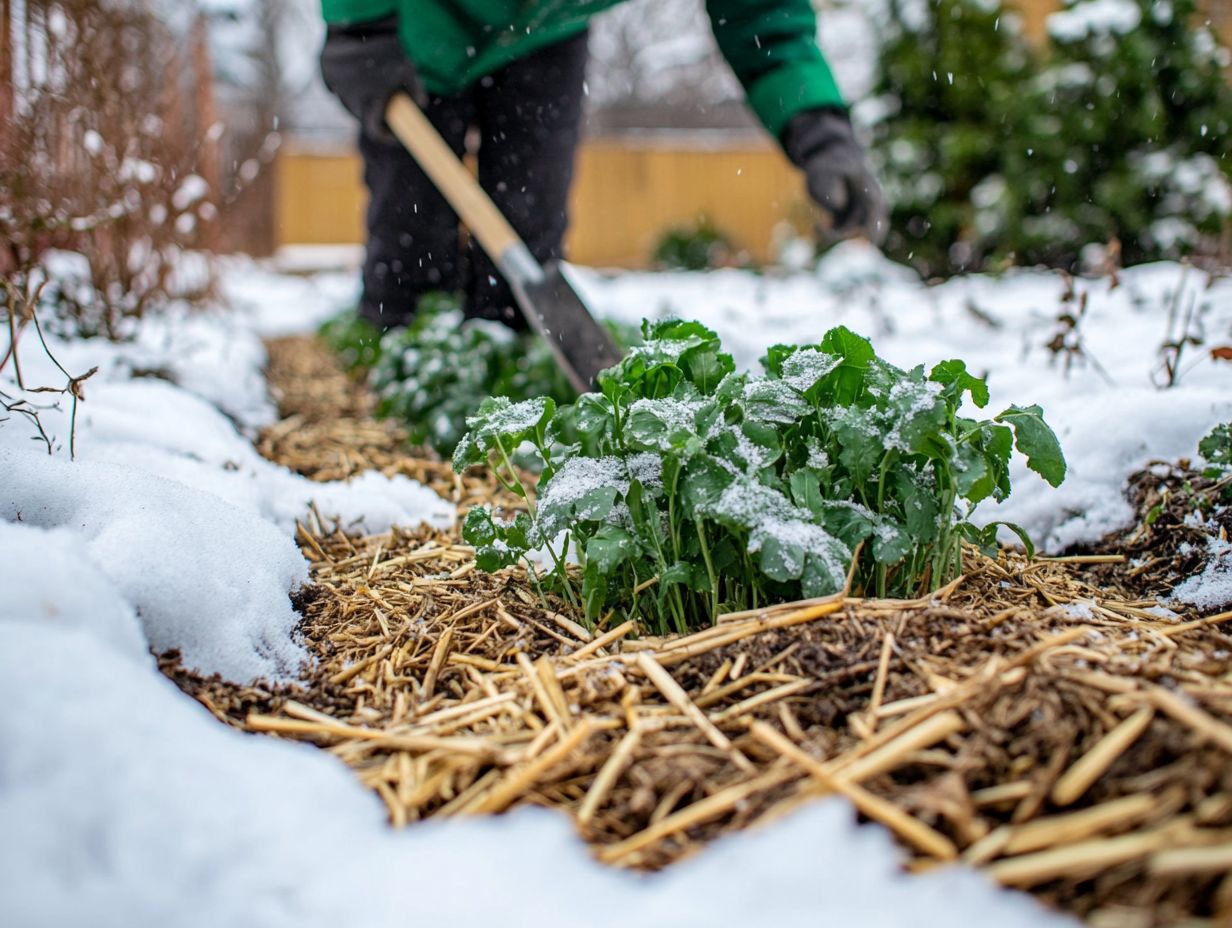
To achieve successful winter mulching, consider following key gardening tips that will enhance the effectiveness of your mulch application and protect your plants during those colder months.
One essential factor is to apply the mulch at just the right time ideally after the first hard frost. This indicates that your plants have entered dormancy. Selecting the appropriate materials is crucial as well; organic options like straw, shredded leaves, or wood chips not only provide insulation but also improve soil fertility over time.
When you mulch, aim for a thickness of 2 to 4 inches. This coverage offers ample protection without suffocating your plants. Just be sure to keep the mulch a few inches away from the plant stems to prevent rot and any moisture-related issues.
Keep these insights in mind to ensure your garden receives optimal winter protection. Don t wait! Mulch your garden before the first frost hits to ensure your plants stay healthy and protected.
Frequently Asked Questions
What Mulching Techniques Work Best in Winter?
Wondering how to best protect your garden this winter? Here are some common questions about the best cold-weather gardening techniques for winter mulching:
What is mulch and why is it important in winter?
Mulch is a layer of material placed on soil. It protects the soil from extreme temperatures, retains moisture, and suppresses weeds. In winter, mulch helps keep the soil warm and protects plant roots from freezing.
What types of mulch are best for winter?
Organic mulches like straw, leaves, and wood chips are ideal for winter. They break down slowly and provide insulation. Avoid using pebbles or rocks, as they can compact and block air and water from reaching the soil.
What are the benefits of winter mulch?
Using winter mulch offers several benefits, including protection from harsh temperatures, moisture retention, and weed suppression. It’s a simple way to keep your garden healthy during the colder months!
How thick should the mulch layer be in winter?
A 2-3 inch layer of mulch is recommended for most plants. However, delicate plants might need a thicker layer of 4-6 inches for extra protection against harsh cold.
When is the best time to apply mulch for winter?
Apply mulch after the first frost but before the ground freezes. This helps the soil cool gradually and prevents trapped moisture from damaging roots.
How to prepare for winter mulch removal?
Before removing mulch in spring, consider whether to spread it out or leave it in place. Organic mulches can enrich the soil as they break down.
Do I need to remove the mulch in spring?
In spring, you can remove or spread out the mulch to warm the soil. If you used organic mulches, consider leaving them to break down and enrich the soil.
Are there any plants that do not need mulching in winter?
Hardy plants like evergreen shrubs and trees can survive without mulch. However, using mulch can still help protect them and keep moisture in the soil!
Don t wait! Prepare your garden today by applying mulch before winter sets in!

